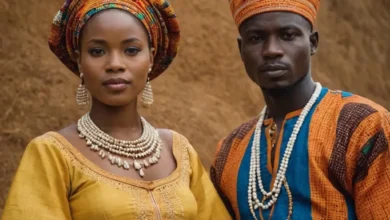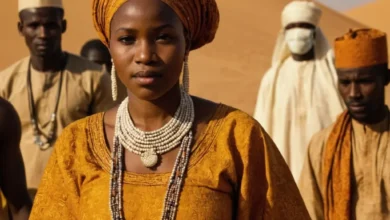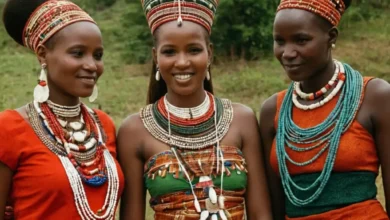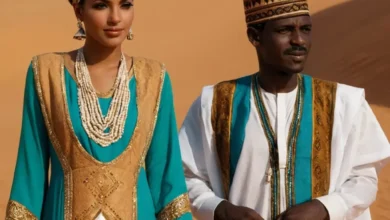Egyptian Traditional Dress
Egypt, a land steeped in history and culture, has a rich and vibrant tradition of clothing. From the majestic attire of ancient pharaohs to the modern-day fashions that blend tradition with contemporary influences, Egyptian dress tells a captivating story of social, religious, and cultural evolution.
A Journey Through Time: Ancient Egyptian Dress
Ancient Egypt, a civilization known for its advanced knowledge and artistic prowess, saw clothing as more than just a means of covering the body. It was a powerful symbol of status, occupation, and religious beliefs. The materials used for clothing varied, with linen being the most prevalent, followed by wool and leather. Cotton, though cultivated in Egypt, was not widely used until later periods.
The Power of Linen: Clothing for All
Linen, a fabric woven from the flax plant, played a crucial role in Egyptian society. Its lightness, breathability, and durability made it ideal for the hot Egyptian climate. The use of linen extended beyond everyday wear, encompassing religious rituals, funerary practices, and even mummification. It was a testament to the Egyptians’ innovative use of natural resources and their deep understanding of textile production.
From Simple Garments to Elaborate Attire: Exploring the Variety
Ancient Egyptian dress, while primarily consisting of simple garments, evolved over time to reflect changing social norms and artistic sensibilities. The shenti, a rectangular piece of linen wrapped around the waist and tied at the side, was the basic garment for men.
See also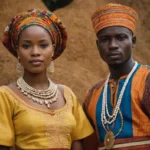 Equatorial Guinean Traditional Clothing: Reflecting Diverse Ethnic and Cultural Influences
Equatorial Guinean Traditional Clothing: Reflecting Diverse Ethnic and Cultural Influences
Women wore the kalasiris, a linen dress that reached down to the ankles and was often adorned with colorful patterns. For both men and women, the nemes, a narrow strip of linen worn around the head, was a common accessory.
As society became more complex, so too did the garments worn by its members. Pharaohs, the rulers of Egypt, wore elaborate attire that emphasized their power and divine status. Their clothing consisted of richly decorated linen, often adorned with gold and precious stones. They wore the khepresh crown, a symbol of royal authority, and the false beard, a symbol of manhood and power.
Beyond Clothing: The Significance of Jewelry and Makeup
Jewelry and makeup played an integral role in Egyptian aesthetics and were considered expressions of beauty and status. Necklaces, bracelets, anklets, and earrings, often made of gold, silver, and precious stones, were worn by both men and women.
Makeup, including eye shadow, kohl eyeliner, and rouge, was used for both practical and symbolic purposes. It protected the eyes from the harsh sun and symbolized the individual’s connection to the divine.
See also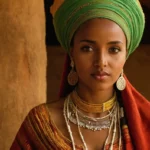 Ethiopian Traditional Clothing: A Rich History Woven in Threads
Ethiopian Traditional Clothing: A Rich History Woven in Threads
The Evolution of Egyptian Dress: From Antiquity to Modernity
With the decline of the ancient Egyptian civilization, dress styles continued to evolve, incorporating influences from neighboring cultures and adopting new materials. The galabiya, a long, flowing garment worn by both men and women, became a prominent part of Egyptian attire. It is believed to have originated in the Arabian Peninsula and was adopted throughout the region during the Islamic conquest of Egypt in the 7th century.
Embracing the Galabiya: A Symbol of Egyptian Identity
The galabiya, a symbol of comfort and modesty, is a staple of Egyptian dress, particularly in rural areas. It is often worn in different colors and patterns, with the white galabiya being the most common. The garment’s loose fit allows for freedom of movement, making it ideal for the hot and humid climate of Egypt.
Beyond the Galabiya: The Diversity of Modern Egyptian Dress
While the galabiya remains a traditional garment, modern-day Egyptian dress exhibits a diverse range of styles. The jibba, a long, loose-fitting tunic, is popular among men and is often worn with a tarboosh, a small, red felt cap. Women’s attire, influenced by Western fashion, often features colorful and vibrant fabrics. The abaya, a long, black cloak, is also commonly worn by women, particularly in religious contexts.
The modern Egyptian fashion scene reflects the country’s multicultural heritage. It incorporates elements of both traditional and contemporary styles, creating a unique aesthetic that is both familiar and forward-looking.
The Social Significance of Egyptian Dress
Clothing plays a vital role in Egyptian society, not only as a means of protection and adornment but also as a reflection of social status, religious beliefs, and cultural identity.
Celebrating Cultural Heritage Through Dress
Egyptian dress is an important expression of national pride and a testament to the country’s rich cultural heritage. The galabiya, the abaya, and other traditional garments are not simply items of clothing but symbols of cultural identity. They serve to connect individuals with their past, their community, and their sense of belonging.
Dress Codes and Religious Observances
In Egypt, as in many other societies, dress codes are influenced by religious beliefs and social norms. The Islamic faith, which is practiced by a majority of Egyptians, emphasizes modesty and humility in clothing.
Men are typically expected to cover their bodies from the waist to the knees, while women are expected to cover their entire bodies, except for their hands and face. However, there is considerable variation in the observance of these norms, with individuals and communities adopting different interpretations of dress codes.
The Future of Egyptian Dress
As Egypt continues to evolve, its fashion scene will undoubtedly reflect these changes. While traditional garments will likely continue to be cherished and worn, modern influences will continue to shape the way Egyptians dress. This fusion of old and new, of tradition and modernity, is a defining characteristic of Egyptian fashion.
The future of Egyptian dress is one of dynamism and adaptation. It will be a tapestry woven with threads of history, culture, and contemporary trends, reflecting the ongoing journey of a nation that is both deeply rooted in its past and open to the possibilities of the future.
FAQs
What is the significance of the **khepresh** crown in ancient Egyptian dress?
The khepresh crown, a tall, pointed crown with a distinctive cobra at the front, was a symbol of royal authority in ancient Egypt. It represented the pharaoh’s divine right to rule and his connection to the gods.
What is the difference between the galabiya and the jibba?
While both the galabiya and the jibba are long, loose-fitting garments, they differ in their style and origin. The galabiya, believed to have originated in the Arabian Peninsula, is a more flowing garment with wider sleeves, while the jibba has a more fitted style and narrower sleeves.
What are some modern trends in Egyptian fashion?
Modern Egyptian fashion combines traditional elements with contemporary influences. Some popular trends include:
- Fusion wear: Blending traditional garments like the galabiya or abaya with modern cuts and designs.
- Ethno-chic: Incorporating traditional Egyptian motifs, colors, and patterns into modern clothing.
- Sustainable fashion: Promoting the use of natural fabrics like cotton and linen, reflecting Egypt’s long tradition of textile production.
From the ancient pharaohs adorned in linen and gold to modern Egyptians blending tradition with contemporary styles, Egyptian dress has always reflected the country’s rich history, culture, and evolution. It is a testament to the enduring power of fashion to communicate social status, religious beliefs, and cultural identity. As Egypt continues to embrace change and innovation, its fashion scene will undoubtedly continue to evolve, reflecting the country’s dynamic and ever-changing spirit.
